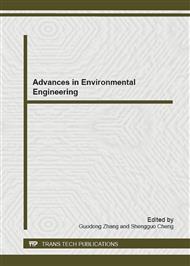p.529
p.533
p.537
p.543
p.547
p.551
p.556
p.560
p.566
Experimental Study on the Permeability of Fresh Municipal Solid Waste
Abstract:
Basing on traditional constant head permeability test with large scale specimen, the permeability of municipal solid waste has been studied. The municipal solid waste material is divided into three parts: the material that is easy to be biodegraded, reinforced material that is difficult to be biodegraded and the incompressible solid waste material. Two different proportions of these three parts, which are 50%, 15%, 35% and 65%, 10%, 25% are selected. A series of laboratory tests have been performed for different initial void ratios, and the initial void ratios are 2.5, 3.0 and 3.5, respectively. Testing results show that the initial void ratio and the content of the organic matter are the main influence factors on the permeability coefficient of the municipal solid waste. Besides, the coefficient of permeability decreases with the decreasement of the initial void ratio of the municipal solid waste. Furthermore, when the proportion of the three parts is 65%, 10% and 25%, the coefficient of permeability varies from 7.8×10-4 to 3.72×10-3 centimeter per second, and when the proportion of three parts is 50%, 15% and 35%, the coefficient of permeability varies from 1.08×10-3 to 6.67×10-3 centimeter per second.
Info:
Periodical:
Pages:
547-550
Citation:
Online since:
November 2012
Authors:
Price:
Сopyright:
© 2012 Trans Tech Publications Ltd. All Rights Reserved
Share:
Citation:


